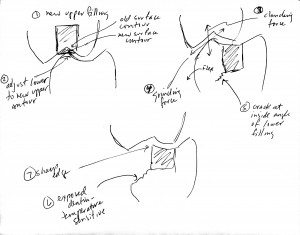
(Diagram credit: David F. Spooner, DDS)
A week and a half ago, I sent a message to Greg at OAR Northwest Mission Control that I had chipped my tooth. When you’re at least 1,000 nautical miles from land, this has the potential to be anything from a slight nuisance to a serious medical emergency. Luckily, Greg’s dad is a dentist so I was able to get some quick help, and a great explanation why this happened. I thought the experience would be valuable to share with all of you, so here are the emails and a diagram! Enjoy…
Adam to Dr. David Spooner, DDS:
“Hi Dave – Thanks for being available to consult about my tooth…
The tooth chipped off my bottom left molar, second from the back. I have a pre-existing filling there, but the chip was real tooth – about the size of a 1-carat diamond. I believe the chip was the result of a poorly adjusted bite. I had just had some dental work 1 week before departing for Senegal, and had significant jaw pain for two-weeks after the initial dental appointment. One week after my first appointment I went back to the dentist for a bite adjustment. The tooth directly above my chipped tooth received the dental work. My tooth chipped where my bite was adjusted.”
Dr. Spooner’s reply:
“Don’t blame the poor chap who did the filling. The lower tooth was sitting there, ready to break. He was unfortunate enough to have touched it last.
Now, look at the diagram: Step 1 – new filling with a contour slightly bulkier than its predecessor.
Step 2 – you came back in and had the opposing tooth adjusted.
The tooth that broke came in when you were about 6 (unless you have your wisdom teeth, in which case it came in when you were 12). It was probably filled within a few years of its coming in. The filling procedure cuts the side wall of the tooth, weakening it slightly. As we go through life we all clench and grind our teeth, putting tremendous cyclical loads on them, hundreds of times per day.
Steps 3/4 – clenching loads the tooth vertically, grinding loads the tooth laterally. Lateral forces cause the tooth to flex microscopically. After thousands of days of hundreds of cyclical loads, step 5, a crack develops at the internal angle of the base of the filling. The crack progresses like a crack in a car windshield until there is not enough intact structure to withstand normal occlusal load. Sometimes the patient experiences cold sensitivity or sensitivity to biting prior to complete fracture. After the fracture – step 6, exposed dentin remains sensitive to cold and, step 7 – a sharp edge is left.”
Adam’s response:
“I am cleaning the chip regularly, and monitoring for pain. Greg suggested (through you) that I find an emery board to file down the sharp edges. We do not have anything like that on board, but the sharp edges have dulled significantly as the tooth is now being used for masticating my food. I tried taking a picture of my tooth but it is too far back in my mouth to get a valuable picture. I believe I should be fine to wait until land to address this tooth issue, with little discomfort. Do you have any other suggestions to ensure I maintain a healthy mouth?”
Dr. Spooner:
“Since the cold sensitivity is subsiding, just keeping it clean is all you need to do. You will probably need a crown when you get back. If the filling comes out, be very careful about chewing on that side of your mouth so the other cusp does not break, too.
Good luck to you guys. You have lots of followers back here. Tell Jordan that book sales at the office are steady. – Dave”


